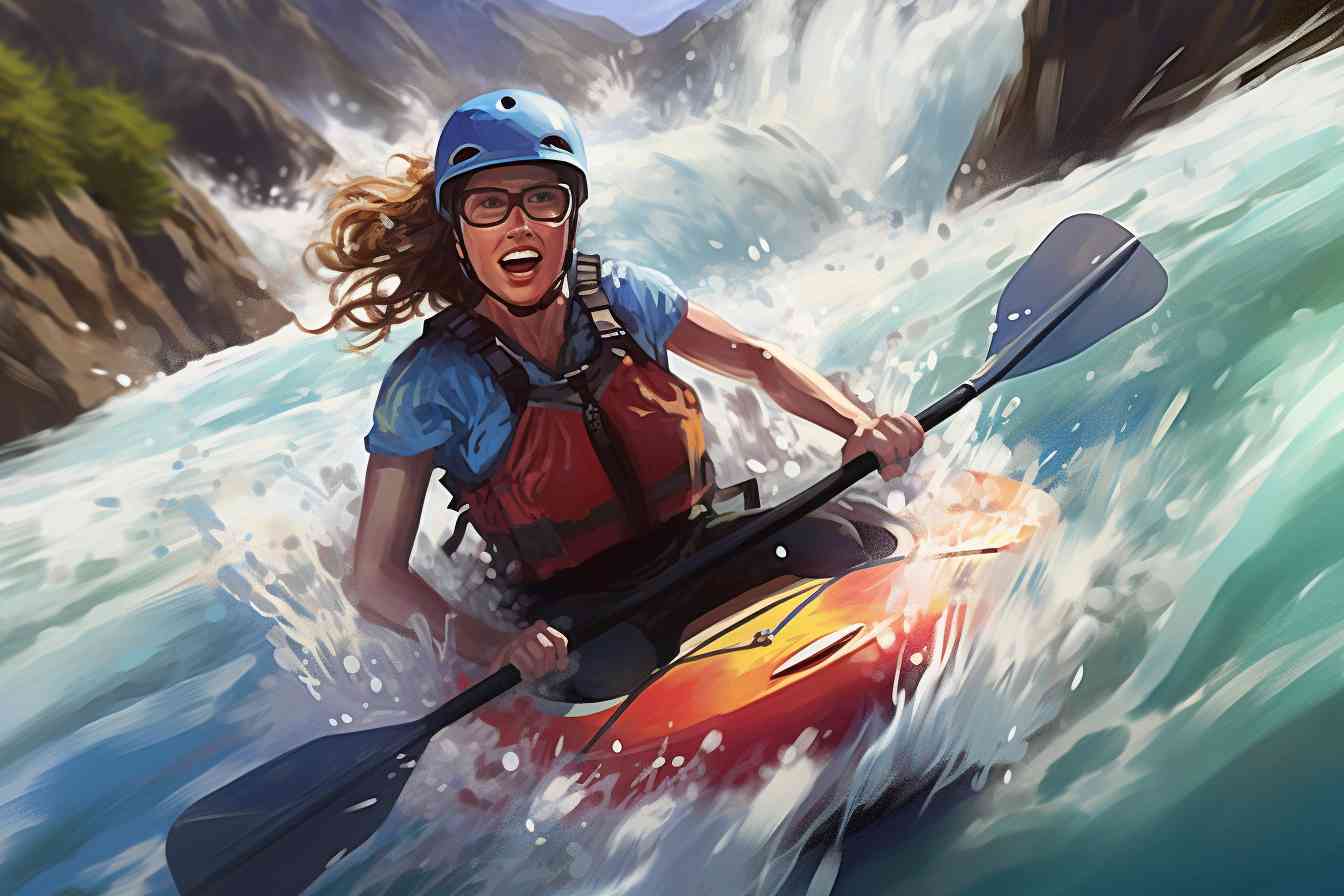Intro: Kayaking While Pregnant

Well, well, well—would ya look at that? You’re pregnant and still mighty keen on kayaking, eh? Hats off to you, my friend! Myself, I’m in awe of ladies like you who keep rockin’ their favorite activities, even with a baby bump. Let me tell you – I think it’s simply flipping fantastic!
However, as fantastic as it is, there are things you gotta consider. I mean, for one, your balance may not be as rock-solid as it was pre-bump. You know what I’m talking about, right? Little Junior in your belly can make you a tad wobbly. And then, of course, there’s the whole shebang about potential risk to you or your baby. I mean, it’s not like you’re purposefully getting tossed about in the waves, but accidents can happen and we ain’t want no part of that! So, it’s essential to ponder the potential risks.
In addition, it’s important to review any health conditions or complications that might make kayaking while pregnant a risky endeavor. Yep—I’m talking about conditions like high blood pressure, preeclampsia, or any other shmancy medical words your doctor might have mentioned. You gotta understand, you ain’t just paddling for one now, you’re paddling for two!
Moreover, you might wanna consider the kind of kayaking you plan on doing. I mean, if it’s flat water kayaking or slow-moving waters, that’s one story. But if it’s whitewater kayaking—I reckon you wanna reconsider. Because let’s face it, diving headfirst into the rapids with a baby on board isn’t the best idea!
Yeah, I know—it’s a lot to think about. But remember, folks—we’re talking about the safety of you and your tiny passenger here. Now don’t get me wrong, I ain’t saying kayaking is off limits. Not by a country mile! But you gotta be smart about it. So take a moment—mull over these points and chat with your doctor. It’s definitely worth a ponder, don’t ya think?
Is It Safe To Kayak During Pregnancy?

Well now, let’s jump right into the deep end of the pool, shall we? Is it safe to kayak while expecting? Good question. It’s a bit of a loaded one, too. Understandably, many women would be nervous about the idea. After all, it seems like quite the precarious situation, right?
Kayaking, in itself, isn’t inherently dangerous. It can actually be quite the enjoyable leisure activity. You get to exercise, connect with nature, and it’s quite calming. But let’s not overlook the elephant in the room – pregnancy does change things up a bit.
When you’re expecting, your body is going through a multitude of changes and sometimes, balance could potentially be thrown off kilter. Accidents could happen, even something as mild as tripping can cause a risk. Not to mention, rowing could possibly put strain on the lower back and abdominal muscles.
So, is it safe? Well, the jury is out. It can be, but it’s not without its risks. If you’re an experienced kayaker and your pregnancy is progressing without complications, kayaking could still be part of your routine – within reason, of course.
But remember, mama bear, you gotta always prioritize yours and your baby’s health. Take things slow, don’t overexert, and always consult with your healthcare provider before heading out for a paddle. After all, as my granny used to say, better to be safe than sorry, right? Always keep in mind – every pregnancy is different and what may work for some, might not for others. So, paddle on, but do it wisely.
Can You Go On A Boat 8 Months Pregnant?

Oooh, that’s a question that really gets the water churning, doesn’t it? In theory, yes. But as with all things pregnancy-related, it’s not just as simple as hopping on board and sailing off into the sunset. The balance of elements in the equation includes safety, physical comfort, and proximity to medical assistance.
First off, if you’re a seasoned mariner, navigating the waters might seem as second nature to you; that doesn’t change when you are pregnant. But, here’s the thing – regardless of your sea-legs, pregnancy can significantly change the game . Our bodies, especially during pregnancy, react differently and unexpectedly to familiar situations . Your trusty sea-legs might not feel so steady with a baby onboard in the literal sense! So, if possible, keep those trips short and sweet and stay close to the shoreline.
Secondly, remember the bump is not just a cute accessory: it’s an additional weight, making balance trickier than usual. Kayaking requires certain strength, flexibility, and balance, which can be a bit of bother when you’re eight months pregnant! Always listen to your body and take note of any discomfort.
Lastly, while we’re all for embracing your adventurous spirit, keep in mind that being eight months pregnant means you’re not exactly close to the finish line . If there’s an emergency, immediate medical attention might not be accessible when you’re out in the middle of a lake or sea . With all these in mind, it’s always best to consult with your healthcare provider before embarking on a boating adventure. So, can you go on a boat 8 months pregnant? Yes, but proceed with caution, and always, always put safety first.
Is It Ok To Paddle Board While Pregnant?

Well now, isn’t that a loaded question? Being an expectant mom doesn’t mean you have to give up your penchant for paddling. But, and this is a big but, there are some crucial factors you need to keep in mind. Would I suggest paddleboarding when you’re pregnant? Yes and no. It really depends on how comfortable and experienced you are in the sport.
You see, paddleboarding, just like any other water sport, comes with a certain level of risk. There’s always the chance of falling in the water, which could potentially endanger the baby. Moreover, paddling can tire you out, especially when you have a mini-you growing inside of you. You do not want to overexert yourself since it could lead to complications.
However, here’s the thing – if you’re a seasoned paddleboarder, used to the motions and balance required, it could not only be okay but also beneficial. Paddleboarding can be quite the workout, strengthening your core, legs, and arms. It could help keep you fit and prepared for the delivery and subsequent recovery process.
But remember, and I can’t stress this enough, take it easy. Don’t push yourself too hard. Be aware of your changing body and its limitations. Do not go paddleboarding alone – always have someone with you. And most importantly, always get the green light from your doctor before you hit the waves.
Pregnancy doesn’t mean putting your life on pause, it’s about finding the fine balance between staying active and keeping safe. So, if you’re keen on paddling and your doctor gives the thumbs up, why not? After all, you deserve to chill out, soak up some sunshine and let the gentle waves lull you into a peaceful state.
Can You Do Water Activities While Pregnant?
Well, lemme tell you, when you’re expecting, it’s not all sacrifices and limitations. You see, the good news is that you can still participate in water activities, including kayaking! Yeah, you heard it right! Ah, feeling that swoosh of the water and the peaceful solitude of being on a river or a lake! Oh! How I cherish those moments!
But before you embark on a kayak, caution! Remember, safety first. Pregnancy tends to throw off your balance, making you more susceptible to slips and falls. So, before you get too giddy, you might want to consider an experienced guide, or look into the local regulations and water conditions. At the end of the day, your health and baby’s safety are paramount, right?
Nonetheless, plenty of pregnant women safely enjoy kayaking. Just ensure you consult with your healthcare provider beforehand. It’s all about balance, moderation, and listening to your body. If you feel uncomfortable, it’s always okay to opt out.
And let’s not forget, make sure your life jacket fits properly over your baby bump. Shame we can’t get custom made life jackets for our bumps, eh? And hydration – so crucial! Pregnant or not, nobody wants to be stuck with dry mouth while paddling against the current.
So, there you go. With necessary precautions, you can continue to embrace your love for kayaking. Just remember, your condition might make you tire quickly. Take it slow, enjoy every paddle stroke and let your spirit of adventure soar… but safely, of course! Enjoy the waters, my friends! And hey, who knows – you might start nurturing a future little kayaker in there!
Final Verdict
Alright! Let’s talk about the final verdict on kayaking while you’re pregnant. Hmm, quite a delicate topic, isn’t it? Before diving headlong into the conclusion, let’s examine the pros and cons one more time, shall we?
On the pro side, kayaking can be a great way to stay fit and active during your pregnancy. It’s an outdoor activity that doesn’t demand extreme physical exertion. Plus, being on the water helps relieve stress and can uplift your mood – a win-win situation if you ask me!
On the other hand, it’s crucial to keep in mind that every woman’s pregnancy is unique. What works for one woman might not work for another. Consequently, while some expectant mothers may feel comfortable and safe kayaking, others might find it discomforting or risky – no two pregnancies are alike, my dear.
So, the final verdict? It’s mostly a personal decision. I’d strongly recommend that you consult with your physician before you get your paddle in hand. They would take your individual health circumstances into account before recommending any form of exercise, including kayaking.
With that said, if you’ve been given the “all-clear” from your doctor, and you feel comfortable, grab your lifejacket and get out there on the water! Remember, keep it easy, stay within your comfort zone, and above all, enjoy your time in mother nature’s lap. After all, these are the moments you’ll cherish forever! Just be sure not to push yourself too hard – it’s not a race, it’s a journey.
That, dear readers, is my final verdict on kayaking while pregnant. Ultimately, you know your body best, so it’s essential to listen to what feels right for you and your little one on board. Happy paddling!
Frequently Asked Questions
Can I go ?
Honestly, it’s a mixed bag – while some ladies feel strong, healthy, and enjoy kayaking during their pregnancy, experts suggest to err on the side of caution. It’s always wise to have a chat with your health care provider first.
Is it safe to kayak in the early stages of pregnancy?
In the early stage of pregnancy, your body isn’t as affected by the physical changes, so many women find it okay to kayak. However, you should still consult your doctor and consider the risks involved.
Is it safe to kayak in the later stages of pregnancy?
During the later stages, the physical changes in your body are more pronounced, and your balance might not be as solid as usual. Therefore, it’s more risky to kayak at this stage – again, talk with your doctor.
What are the risks of ?
The main risks include tipping over, exertion, and dehydration. Remember safety comes first, so if you decided to kayak, do it cautiously and within your comfort level.
Are there specific safety measures for pregnant women who want to kayak?
Absolutely – if you’re given the all-clear to kayak while pregnant, ensure you have a well-fitting life jacket, stay hydrated, avoid rapid rivers, and keep close to the shore.
Can I do whitewater ?
Whitewater kayaking is risky due to its fast currents and rocky undercurrents. I’d give it a thumbs-down while you’re expecting – safety first, always!
Are there any benefits to ?
Ah, there’s the rub! Kayaking can help relieve stress and provide a great low-impact workout. But remember, it’s not worth risking if your doctor advises against it.
Can I do sea ?
Sea kayaking might be safer than whitewater kayaking because the currents aren’t as strong. That said, it can also be unpredictable with waves and tides. So it’s a judgement call to make with your doctor.
Can extreme heat affect my kayaking experience while pregnant?
Yes, it can. Pregnant women often feel warmer and might have trouble with heat regulation, so it’s important to avoid overly hot days and stay hydrated.
Can I start kayaking if I never did it before I became pregnant?
If you’ve never done it before, it might be better to wait until after the pregnancy. Kayaking requires balance and knowledge of safety measures which you might not be familiar with as a newbie. Always best to not rock the boat, eh?

